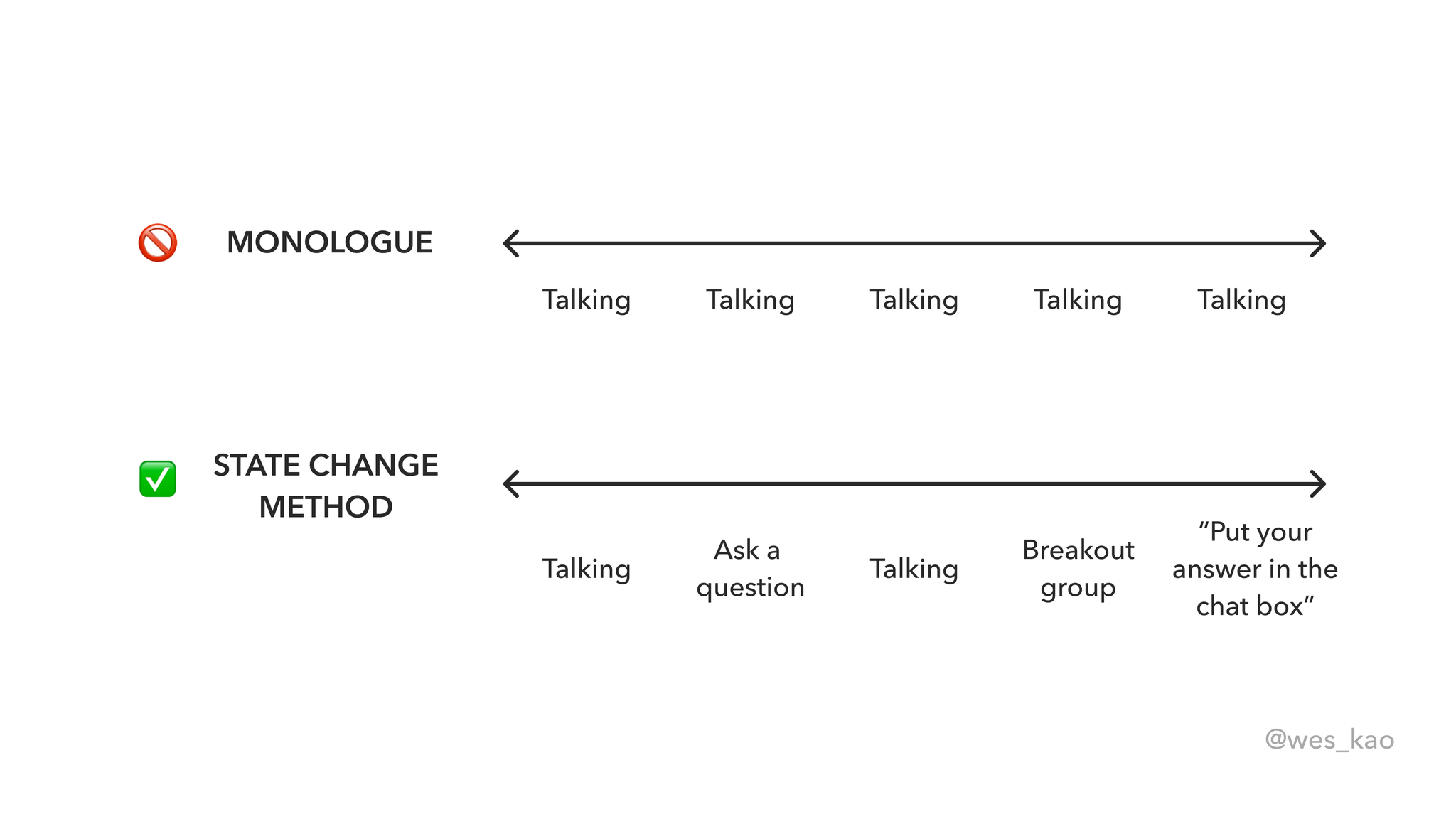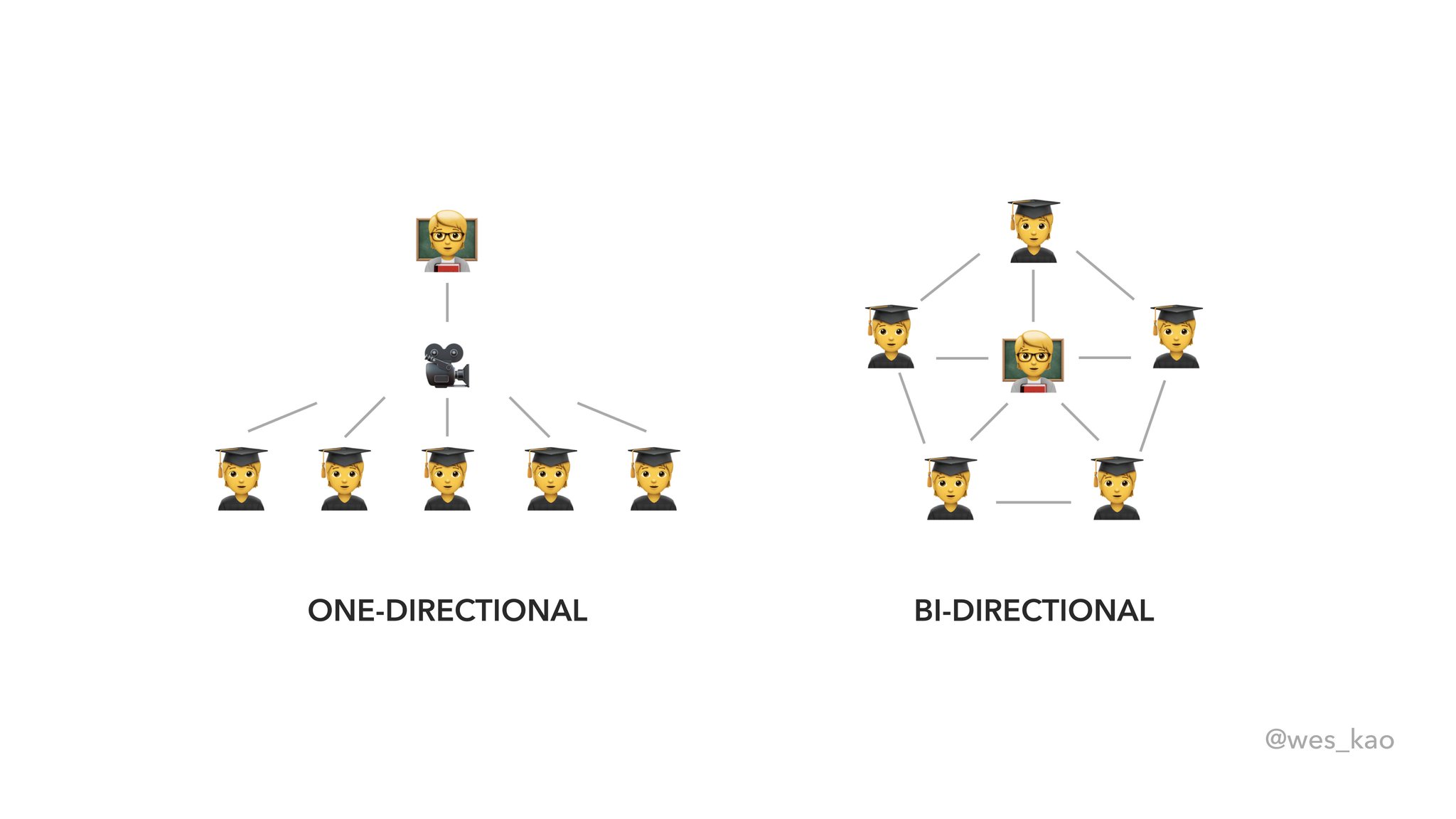Thread
Most people struggle to lead engaging meetings & presentations.
But whether officially or unofficially, leaders fill the role of a teacher.
Here’s how to keep “students” hooked in a digital world:
But whether officially or unofficially, leaders fill the role of a teacher.
Here’s how to keep “students” hooked in a digital world:
On a weekly basis, you teach & explain your ideas to those around you.
You might
• Teach employees
• Teach a guest lecture
• Teach via content/writing
It’s your responsibility to keep your audience engaged so they're motivated to pay attention.
You might
• Teach employees
• Teach a guest lecture
• Teach via content/writing
It’s your responsibility to keep your audience engaged so they're motivated to pay attention.
1. Use the State Change Method
The average student attention span is only 2-4 min.
To keep audiences awake, aim for a “state change” every few minutes to break up the monotony.
A state change is anything that punctuates your monologue—it causes students to snap to attention.
The average student attention span is only 2-4 min.
To keep audiences awake, aim for a “state change” every few minutes to break up the monotony.
A state change is anything that punctuates your monologue—it causes students to snap to attention.
Monotony causes audiences to tune out.
Movement causes audiences to become alert.
State changes create a sense of movement, which speeds up the *perceived pacing* of your presentation.
• Breakout rooms
• Polls
• Discussions
• Comments in chat box
Movement causes audiences to become alert.
State changes create a sense of movement, which speeds up the *perceived pacing* of your presentation.
• Breakout rooms
• Polls
• Discussions
• Comments in chat box
2. Embrace a bi-directional approach
Traditional presentations are one-directional: a “sage on stage” talks & everyone else listens.
Cohort-based learning is bi-directional:
1. Expert to student
2. Student to student
Learning happens from all directions.
Traditional presentations are one-directional: a “sage on stage” talks & everyone else listens.
Cohort-based learning is bi-directional:
1. Expert to student
2. Student to student
Learning happens from all directions.
🚫 Before: “I will talk at you for an hour.”
✅ After:
Instructor: [Shares a framework]
Student 1: [Applies framework to a new situation]
Student 2: [Shares an alternative POV]
Student 3: [Shares how the framework works in their industry]
✅ After:
Instructor: [Shares a framework]
Student 1: [Applies framework to a new situation]
Student 2: [Shares an alternative POV]
Student 3: [Shares how the framework works in their industry]
3. Teach how to execute
A common mistake is spending too much time staying high level & only explaining *why* a topic is important.
The "why" is important, but it's not enough.
Your students want to know HOW to do what you do.
A common mistake is spending too much time staying high level & only explaining *why* a topic is important.
The "why" is important, but it's not enough.
Your students want to know HOW to do what you do.
🚫 “Here’s why communication is important as a product manager.”
→ 99% of PMs already know why communication matters. You don’t need to spend half an hour on this.
→ 99% of PMs already know why communication matters. You don’t need to spend half an hour on this.
✅ “Here’s how PMs can make high-conviction decisions and lead teams through ambiguity, even if you don’t have positional authority.”
→ PMs want to know HOW to level up their communication.
Share real-life examples of how to get buy-in, how to make a strong business case, etc
→ PMs want to know HOW to level up their communication.
Share real-life examples of how to get buy-in, how to make a strong business case, etc
4. Create opportunities for hands-on practice
Fight the urge to give your students all the answers.
When a student (or direct report) approaches you with a question, let them think about how they would answer.
Give them the chance to think rigorously.
Fight the urge to give your students all the answers.
When a student (or direct report) approaches you with a question, let them think about how they would answer.
Give them the chance to think rigorously.
🚫 Before: “I’m going to lecture for an hour. Then I’ll take your questions.”
✅ After: “Great question. I’m curious what y’all think. Everyone take 30 seconds to think about it and write your answers in the chat. Then we can unpack this together…”
✅ After: “Great question. I’m curious what y’all think. Everyone take 30 seconds to think about it and write your answers in the chat. Then we can unpack this together…”
5. Add interactivity
Students rarely say they want more lectures.
What do they say?
“I wish there were more chances to meet students and get feedback from my peers.”
When in doubt, add more interactivity. Not more content.
Students rarely say they want more lectures.
What do they say?
“I wish there were more chances to meet students and get feedback from my peers.”
When in doubt, add more interactivity. Not more content.
🚫 “That’s my process for closing a sale. Now, let’s move on to follow-up emails.”
✅ “Let’s role play what you just learned with closing a sale. I need a volunteer to close me on buying their product. Then we’ll spend 5 min giving feedback & they’ll iterate on their pitch.”
✅ “Let’s role play what you just learned with closing a sale. I need a volunteer to close me on buying their product. Then we’ll spend 5 min giving feedback & they’ll iterate on their pitch.”
Your goal is student transformation.
You won’t achieve this solely by filling the room with your voice. Instead, focus on improving your students’ experience & give them a chance to practice what they’re learning.
Give these tactics a shot and let me know what you think.
You won’t achieve this solely by filling the room with your voice. Instead, focus on improving your students’ experience & give them a chance to practice what they’re learning.
Give these tactics a shot and let me know what you think.
That’s all for today.
If you found this valuable:
1. Follow me for threads on leadership, education, marketing → @wes_kao
2. If you're an expert ready to share your knowledge, check out the @MavenHQ Course Accelerator
bit.ly/3O0Mo3K
If you found this valuable:
1. Follow me for threads on leadership, education, marketing → @wes_kao
2. If you're an expert ready to share your knowledge, check out the @MavenHQ Course Accelerator
bit.ly/3O0Mo3K



